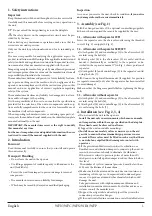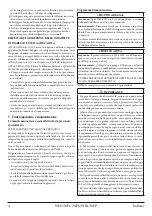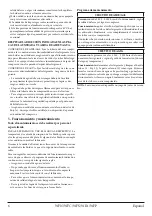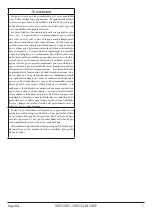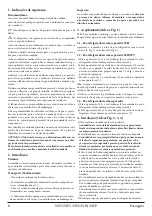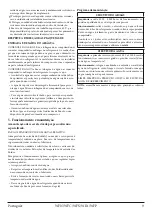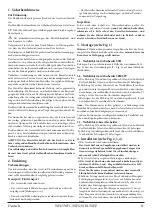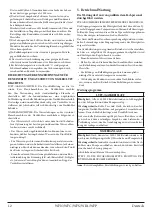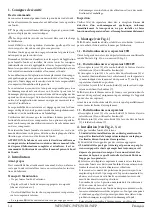
1
English
WFN/WFC/WFS/WFA/WFP
1. Safety instructions
Important:
Keep this manual with the unit throughout its entire service life;
Carefully read this manual before carrying out any operation on
the unit;
Y
Do not exceed the design limits given on the dataplate.
!
Th
e safety devices on the compressed air circuit must be pro-
vided for by the user.
Before starting any maintenance operations, make sure that the
circuits are not under pressure.
Only use the unit for professional work and for its intended pur-
pose.
Th
e user is responsible for analysing the application aspects for
product installation, and following all the applicable industrial and
safety standards and regulations contained in the product instruc-
tion manual or other documentation supplied with the unit.
Tampering or replacement of any parts by unauthorised personnel
and/or improper machine use exonerate the manufacturer from all
responsibility and invalidate the warranty.
Th
e manufacturer declines and present or future liability for dam-
age to persons, things and the machine, due to negligence of the
operators, non-compliance with all the instructions given in this
manual, and non- application of current regulations regarding
safety of the system.
Th
e manufacturer declines any liability for damage due to altera-
tions and/or changes to the packing.
It is the responsibility of the user to ensure that the specifi cations
provided for the selection of the unit or components and/or op-
tions are fully comprehensive for the correct or foreseeable use of
the machine itself or its components.
When requesting technical assistance or ordering spare parts, al-
ways quote the model and serial number on the identifi cation plate
mounted externally on the unit.
IMPORTANT:Th
e manufacturer reserves the right to modify
this manual at any time.
For the most comprehensive and updated information, the user
is advised to consult the manual supplied with the unit.
2. Introduction
Foreword
Read this manual carefully to ensure that you install and operate
this unit correctly.
Transport / Handling
• Do not leave the unit in the open air.
• Use lift ing equipment of suitable capacity to lift and move the
unit (fork lift etc.).
• Protect the unit from impact to prevent damage to internal
components.
• Th
e manufacturer assumes no liability for damages
• Which may be caused by decayed or modifi ed packaging.
Inspection
As soon as you receive the unit, check its condition;
if you notice
any damage inform the carrier immediately.
3. Assembly (see Fig. 1)
N.B.:
For fl anged models, if the optional counterfl anges/gaskets
kit has not been acquired these must be supplied by the user.
3.1 - Aft ercooler with separator STH
Screw the separator onto the aft ercooler outlet using the threaded
curve (1-Fig. 3) or nipple (2-Fig. 3).
3.2 - Aft ercooler with separator SFH/SFV
a) Attach gasket (2) and counterfl ange (3) to the aft ercooler’s (1)
air inlet using the bolts (6).
b) Attach gasket (4) to the aft ercooler’s (1) air outlet and then
mount it (horizontally or vertically) to the separator, as de-
scribed in the separator manual (*) in Fig. 1 shows position of
separator.
c) Attach gasket (8) and counterfl ange (5) to the separator’s outlet
using the bolts (7).
N.B.:
Connect the optional thermometer (if supplied - for position
see separator manual) only aft er the apparatus has been installed
(to avoid damage).
Make sure that the fl anges are parallel before tightening the fl ange
bolts.
3.3 - Aft ercooler without separator
a) Attach gasket (2) and counterfl ange (3) to the aft ercooler’s (1)
air inlet using the bolts (6).
b) Attach gasket (4) and counterfl ange (5) to the aft ercooler’s (1)
air outlet using the bolts (7).
4. Installation (see. Fig. 2, 3, 4)
a) Do not install the unit in the open air.
Install the unit only in environments which ensure an ambi-
ent temperature within the range specifi ed on the data plate.
Th
ese limits must be observed in all cases.
b) Support the unit on suitable mountings.
c) Install one or more safety valves as necessary on the air/
gas side to ensure that maximum design pressure is never
exceeded. Th
ese valves must be fi tted in such a way that there
is no risk of any expelled fl uid coming into contact with
operators.
d) If the pressurised fl uid circuit is subject to vibration, use
fl exible hoses and vibration dampers to connect up the unit, or
secure the circuit more fi rmly to eliminate the vibrations.
If the circuit is subject to pressure pulses of more than 10%
rated pressure, install a pulse damper to reduce them to below
this level.
Th
e number of cycles at nominal pressure 0 must be less than
1000 over the lifetime of the machine.
e) Make sure that the air around the unit does not contain con-
taminating solids or gases. Compressed and condensed gases
can react to produce acids and other chemicals which could
damage the unit.
Take particular care with sulphur, ammonia, chlorine and
installations in marine environments. For further advice or as-
sistance consult the manufacturer.
f) Support the air/gas inlet and outlet pipes if they strain the
connection ports and/or fl anges.
g) If the unit is installed in a seismic zone, install suitable devices



